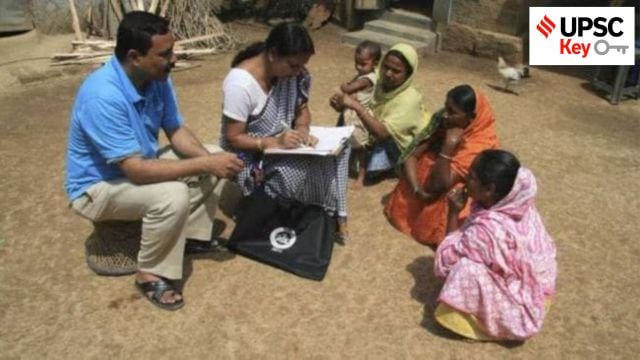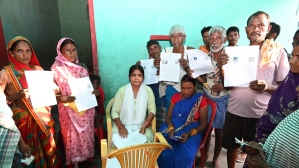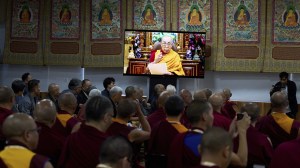UPSC Key: Radiocarbon dating, Census and Justice Hema Committee Report
Why Post-Retirement Appointments for Judges is relevant to the UPSC exam? What is the significance of topics such as Australia-India Strategic Research Fund, Accelerator Mass Spectrometry and Asian Development Bank on both the preliminary and main exams? You can learn more by reading the Indian Express UPSC Key for June 5, 2025.
 UPSC Key June 2025: Here's what you should be reading from the June 5, 2025 edition of The Indian Express
UPSC Key June 2025: Here's what you should be reading from the June 5, 2025 edition of The Indian Express Important topics and their relevance in UPSC CSE exam for June 5, 2025. If you missed the June 4, 2025 UPSC CSE exam key from the Indian Express, read it here
FRONT PAGE
RCB victory march a fatal crush: 11 dead as Govt, team admn slip
Syllabus:
Preliminary Examination: Current events of national and international importance.
Mains Examination: General Studies III: Disaster and disaster management.
What’s the ongoing story: Behind Wednesday’s stampede in Bengaluru, which occurred as thousands gathered to celebrate the IPL victory of Royal Challengers Bangalore, lies an apparent lack of planning, an underestimation of the number of fans who would gather, and confusion over the free passes available to allow entry to the Chinnaswamy Stadium.
Key Points to Ponder:
• What is stampede
• What triggered stampede in Bengaluru?
• What are the primary causes of stampedes?
• How do people die at these events?
• ‘These kind of events exposes lax safety rules and regulatory failures’-Discuss
• What role did the ‘rumour’ play in these events?
• Is there any National Guide on Crowd Management in India?
• Stampedes in India-know in detail
Key Takeaways:
• On Wednesday morning, the team’s management announced that they would hold a victory parade in an open bus from Vidhana Soudha to the stadium, roughly 1 km away, before an event at the stadium for which limited free passes would be available online.
• At 11:56 am on Wednesday, however, the traffic police announced that there would be no victory parade. Around 1:30 pm, the RCB team arrived at HAL airport and took a bus to the hotel before proceeding to Vidhana Soudha. By then, thousands had gathered around the Vidhana Soudha, where Karnataka Chief Minister Siddaramaiah was scheduled to felicitate the team.
• Some in the crowd climbed trees, while others found a way to the top of the Karnataka High Court building. Simultaneously, the crowd swell near the M Chinnaswamy cricket stadium. Around this time, the Namma Metro announced that the trains would not stop at Cubbon Park and Dr BR Ambedkar stations due to the heavy footfall.
• According to officials investigating the incident, the crowd expected that after the felicitation, the open bus would head towards the stadium. As many did not have tickets to enter the venue, they hoped they would at least catch a glimpse of the cricket stars on the bus, unaware that the victory parade had been cancelled.
• There were around 2-3 lakh people on the streets, including 1 lakh near the Vidhana Soudha, he said. “We, or the Karnataka State Cricket Association, did not expect such a huge crowd. The stadium capacity is around 35,000. We anticipated that there would be a little more than that,” he said.
Do You Know:
• Wenguo Weng and others define a stampede as “an impulsive mass movement of a crowd that often results in injuries and deaths”. (‘Review of analyses on crowd-gathering risk and its evaluation methods’, 2023).
• According to Illiyas and others, a stampede can be described as the “disruption of the orderly movement of crowds… leading to injuries and fatalities”, often “in response to a perceived danger, loss of physical space”, or “a will to attain something seen as gratifying”.
• Most stampede casualties are caused by traumatic asphyxia — there is partial or complete cessation of respiration due to external compression of the thorax and/or upper abdomen. Notably, significant compression forces, enough to hurt and kill humans, have been reported in even moderate crowds of six to seven people pushing in one direction.
• Other possible reasons for stampede-related deaths include myocardial infarction (heart attack, caused by decreased or complete cessation of blood flow to a portion of the heart), direct crushing injury to internal organs, head injuries, and neck compression.
• Stampedes almost always take place during mass gatherings — either spontaneous gatherings, like in a metro station during the rush hour, or planned ones, like the Hathras satsang stampede in July 2024, which claimed at least 116 lives..
• Almost all stampedes are either triggered or made worse by panic. In a seminal paper, psychologist Alexander Mintz theorised that “in panic-producing situations cooperative behavior is needed for success and is rewarding to individuals as long as everybody cooperates. However, once the cooperative pattern of behavior is disturbed, cooperation ceases to be rewarding to the individuals”. (‘Non-adaptive group behavior’, 1952).
Other Important Articles Covering the same topic:
Previous year UPSC main Question Covering similar theme:
📍Discuss the recent measures initiated in disaster management by the Government of India departing from the earlier reactive approach. (2020)
Judges who get govt jobs, join politics after retiring invite scrutiny: CJI
Syllabus:
Preliminary Examination: Current events of national and international importance.
Mains Examination: General Studies IV: Public/Civil service values and Ethics in Public administration
What’s the ongoing story: Making clear he has decided not to accept any post-retirement role or position from the government, Chief Justice of India B R Gavai has said that judges taking up government appointments “immediately after retirement” or resigning to contest elections “raises significant ethical concerns and invites public scrutiny”.
Key Points to Ponder:
• Post-Retirement Appointments for Judges-Discuss
• “Judges taking up government appointments immediately after retirement or resigning to contest elections raises significant ethical concerns and invites public scrutiny”-Comment
• What are the ethical concerns in the post-retirement appointments for Judges?
• Do you think that the post-retirement conduct of judges has a bearing on public confidence in the judiciary?
• What measures can be institutionalized to safeguard the independence of the judiciary post-retirement?
• How does the doctrine of separation of powers apply to the Indian judiciary, especially regarding appointments post-retirement?
Key Takeaways:
• He was speaking at a roundtable Tuesday at the UK Supreme Court, hosted by Lord Reed of Allermuir, President of the UK Supreme Court.
• Explaining how the Collegium system of appointing judges to constitutional courts came into being, CJI Gavai, while acknowledging that “there may be criticism of the Collegium system”, said “any solution must not come at the cost of judicial independence”. He sought to underline that “judges must be free from external control”.
• Referring to the debate around judges accepting post-retirement jobs, the CJI said “if a judge takes up another appointment with the government immediately after retirement, or resigns from the bench to contest elections, it raises significant ethical concerns and invites public scrutiny”.
• He said “a judge contesting an election for a political office can lead to doubts regarding the independence and impartiality of the judiciary, as it may be seen as a conflict of interest or as an attempt to gain favour with the government”.
• He said “the timing and nature of such post-retirement engagements could undermine the public’s trust in the judiciary’s integrity, as it could create a perception that judicial decisions were influenced by the prospect of future government appointments or political involvement”.
• The CJI admitted that “there have been instances of corruption and misconduct that have surfaced even within the judiciary,” and said “such occurrences inevitably have a negative impact on public confidence, potentially eroding faith in the integrity of the system as a whole”.
Do You Know:
Abhinav Chandrachud Writes:
• Retired judges have been appointed to political office since Prime Minister Jawaharlal Nehru’s tenure. However, the time has come for us to ask a difficult question: Should judges stop accepting post-retirement jobs offered by the government, at least for a few years after retiring, because accepting such posts could undermine the independence of the judiciary?
• Unlike federal judges in the US, judges in India do not hold office for life. They remain in office until they reach the retirement age — 65 for Supreme Court judges and 62 for high court judges. These judges do not hold their offices at the “pleasure” of the President. In other words, they cannot be arbitrarily removed by the government once they are appointed, and can only be impeached by a supermajority of both houses of Parliament “on the ground of proved misbehaviour or incapacity”. The impeachment process is a very difficult one and never in the history of independent India has a judge been impeached, though attempts have sometimes been made to do so. Judges, therefore,
enjoy security of tenure while holding office, which is essential for maintaining judicial independence.
• The Constitution provides that a retired Supreme Court judge cannot “plead or act in any court or before any authority within the territory of India”. In the Constituent Assembly, K T Shah, an economist and advocate, suggested that high court and Supreme Court judges should not take up an executive office with the government, “so that no temptation should be available to a judge for greater emoluments, or greater prestige which would in any way affect his independence as a judge”. However, this suggestion was rejected by B R Ambedkar because he felt that the “judiciary decides cases in which the government has, if at all, the remotest interest, in fact no interest at all”.
• In Ambedkar’s time, the judiciary was engaged in deciding private disputes and rarely did cases arise between citizens and the government. “Consequently”, said Ambedkar, “the chances of influencing the conduct of a member of the judiciary by the government are very remote”. This reasoning no longer holds today because the government is one of the largest litigants in the courts.
• In its 14th report in 1958, the Law Commission noted that retired Supreme Court judges used to engage in two kinds of work after retirement: Firstly, “chamber practice” (a term which would, today, mean giving opinions to clients and serving as arbitrators in private disputes) and secondly, “employment in important positions under the government”. The Law Commission frowned upon chamber practice, but did not recommend its abolition. However, it strongly recommended banning post-retirement government employment for Supreme Court judges because the government was a large litigant in the courts. The Commission’s recommendations were never implemented.
Other Important Articles Covering the same topic:
📍Time has come to ask: Should judges stop accepting post-retirement jobs offered by govt
EXPRESS NETWORK
India, Australia agrees to work together to combat terrorism
Syllabus:
Preliminary Examination: Current events of national and international importance.
Main Examination: General Studies II: Bilateral, regional and global groupings and agreements involving India and/or affecting India’s interests.
What’s the ongoing story: DEFENCE MINISTER Rajnath Singh Wednesday held a bilateral meeting with his Australian counterpart Richard Marles, in which both sides agreed to work together to combat terrorism in all forms and agreed to intensify and diversify defence industry collaboration under the Australia-India Joint Research Project.
Key Points to Ponder:
• What is the Australia-India Strategic Research Fund (AISRF)?
• Examine India and Australia bilateral relationship in detail
• The India-Australia bilateral relationship-What history says?
• Strategic ties between India-Australia-How they have evolved?
• How has the Quad impacted trade relations between India and Australia?
• India-Australia Economic Cooperation and Trade Agreement (INDAUS ECTA)-Key Proposals
• India-Australia Defence Cooperation-What are the Key Proposals and takeaways?
• How do Australia and India working together to combat terrorism?
Key Takeaways:
• Marles is on a two-day official visit to India. The visit marks his first to India after his re-appointment as Australia’s Deputy Prime Minister and Minister of Defence.
• In a statement, the Defence Ministry said that both Ministers strongly condemned the terror attack in Pahalgam and expressed deepest condolences to the families of the victims. It said Singh highlighted India’s right to respond in self-defence against cross-border terrorism and described New Delhi’s actions against Pakistan as measured, non-escalatory, proportionate and responsible.
• The defence ministry statement noted that they had deliberated on furthering defence science and technology collaboration projects when they meet in Australia later this year for the third India-Australia 2+2 ministerial meeting.
• The meeting offered an opportunity to both sides to review the status of bilateral engagements in the context of emerging regional and global scenarios.
• Both sides expressed satisfaction and recognised that defence has emerged as an important pillar of the collaboration on the fifth anniversary of the signing of the India-Australia Comprehensive Strategic Partnership. “Both countries expressed satisfaction at the growing strategic convergence between the two countries and agreed to work together towards a free and open Indian Ocean and Pacific Island region,” the statement said.
• India and Australia also called for the continued strengthening of bilateral defence cooperation and their commitment for achieving their shared objective of peace, prosperity, stability and progress in the Indo-Pacific region.
Do You Know:
• The Australia-India Strategic Research Fund (AISRF) is a bilateral program that supports collaborative research projects between Australia and India. It aims to strengthen the scientific relationship between the two countries and address common challenges through joint research efforts.
• The India-Australia bilateral relationship has been underpinned by the shared values of pluralistic, Westminster-style democracies, Commonwealth traditions, expanding economic engagement, and increasing high-level interaction.
• Several common traits, including strong, vibrant, secular, and multicultural democracies, a free press, an independent judicial system, and English language, serve as the foundation for closer co-operation and multifaceted interaction between the two countries.
• The end of the Cold War and beginning of India’s economic reforms in 1991 provided the impetus for the development of closer ties between the two nations. The ever-increasing numbers of Indian students travelling to Australia for higher education, and the growing tourism and sporting links, have played a significant role in strengthening bilateral relations.
• With the passage of time, ties evolved in the direction of a strategic relationship, alongside the existing economic engagement. In recent years, the relationship has charted a new trajectory of transformational growth. With greater convergence of views on issues such as international terrorism, and a shared commitment to a rules-based order in the Indo-Pacific region, the two democracies have taken their cooperation to plurilateral formats, including the Quad (with the United States and Japan).
• The 2+2 Ministerial Dialogue was held in September 2021, and the Deputy Prime Minister and Defence Minister of Australia visited in June 2022. The Mutual Logistics Support Agreement (MLSA) was concluded during the Virtual Summit in June 2020, and the two militaries held several joint exercises in 2022. Australia will host military operations with India, Japan, and the US in the “Malabar” exercises off the coast of Perth in August, and has invited India to join the Talisman Sabre exercises later this year.
Other Important Articles Covering the same topic:
📍The India-Australia relationship
Previous year UPSC main Question Covering similar theme:
📍Quadrilateral Security Dialogue (Quad) is transforming itself into a trade bloc from a military alliance, in present times Discuss. (UPSC, 2020)
Kutch housed hunter-gatherers 5,000 yrs. before Harappans arrived: Study
Syllabus:
Preliminary Examination: History of India
Mains Examination: General Studies I: Indian culture will cover the salient aspects of Art Forms, literature and Architecture from ancient to modern times.
What’s the ongoing story: Shell scatters, deposits, middens, stone tools. Researchers have found rare evidence of human settlement in Kutch. As they dug deeper, they found that Kutch was home to prehistoric hunter-gatherer communities way before the Harappan era. A recent study by researchers at the Indian Institute of Technology Gandhinagar (IITGN) has offered new insights into Kutch’s cultural evolution.
Key Points to Ponder:
• Which regions has recently been found to have housed hunter-gatherer communities 5,000 years before the Harappan civilisation?
• What is the Accelerator Mass Spectrometry (AMS)?
• Why is C14 used in carbon dating?
• The study about pre-Harappan hunter-gatherers in Kutch was based on what scientific analyses?
• Discuss the significance of recent archaeological findings in Kutch that point to a pre-Harappan hunter-gatherer presence.
• How the study of microliths and material culture can help reconstruct prehistoric human settlements in India.
• How do environmental conditions of prehistoric Kutch contribute to understanding ancient human migration and settlement patterns in India?
Key Takeaways:
• The study by IITGN researchers, in collaboration with experts from IIT Kanpur (IITK), Inter University Accelerator Centre (IUAC) Delhi, and Physical Research Laboratory (PRL) Ahmedabad, has uncovered archaeological evidence that pushes back the human presence in this region by at least 5,000 years prior to the arrival of Harappans.
• These communities inhabited a mangrove-dominated landscape, relied on shell species (both bivalves like oysters and gastropods), and naturally adapted to such environments.
• These newly identified sites are the first of their kind to be documented in the Kutch region, with a defined cultural and chronological context. According to the researchers, the findings also show similarities with coastal archaeological sites in the Las Bela and Makran regions of Pakistan and the Oman Peninsula, suggesting that early coastal communities across this broader region may have developed comparable strategies for food collection and survival.
• To determine the age of these sites, the researchers used Accelerator Mass Spectrometry (AMS), a precise method for measuring the radioactive isotope values of Carbon-14 (C-14) from the shell remains, which is absorbed by all living organisms.
• After death, C-14 begins to decay and is reduced by half every 5,730 years. Measuring the remaining amount in the shell samples allows scientists to estimate how long ago the organism died. As atmospheric C-14 levels have varied over time, the results were calibrated using tree ring data. Trees form one ring per year, and these tree ring sequences can be matched and extended back over thousands of years, allowing scientists to construct an accurate reference timeline of atmospheric C-14.
• The researchers also believe that the shell middens and scatters will be important in palaeoclimate studies. Since climate change unfolds gradually over millennia and cannot be directly observed in the short term, natural materials like shells preserve signals that help reconstruct past environments.
• The findings from this study were presented at the 17th Annual Workshop on South Asian Archaeology (Hartwick College and University of Chicago), the Seminar Series on the Archaeology of the Indo-Iranian Borderlands (Sorbonne University, Paris), and the 50th Annual Conference of the Indian Society for Prehistoric and Quaternary Studies (ISPQS), Raipur — all in 2025.
Do You Know:
• Radiocarbon dating, or carbon-14 dating, is a scientific method that can accurately determine the age of organic materials as old as approximately 60,000 years. First developed in the late 1940s at the University of Chicago by Willard Libby, the technique is based on the decay of the carbon-14 isotope. Radiocarbon dating has been used for historical studies and atmospheric science, and triggered archaeology’s “radiocarbon revolution.”
• Carbon dating is a widely-used method to establish the age of organic materials, things that were once living. Living things have carbon in them in various forms. The dating method is based on the fact that Carbon-14 (C-14), an isotope of carbon with an atomic mass of 14, is radioactive, and decays at a well-known rate. This is how it works: The most abundant isotope of carbon in the atmosphere is C-12. A very small amount of C-14 is also present. The ratio of C-12 to C-14 in the atmosphere is almost static, and is known.
• Plants get their carbon through photosynthesis; animals get it mainly through food. Because plants and animals get their carbon from the atmosphere, they too acquire C-12 and C-14 in roughly the same proportion as is available in the atmosphere.
Other Important Articles Covering the same topic:
ECONOMY
Defence equipment, oil, cars: Where India could lower tariffs to reach deal with US
Syllabus:
Preliminary Examination: Current events of national and international importance.
Mains Examination: General Studies II: Bilateral, regional and global groupings and agreements involving India and/or affecting India’s interests.
What’s the ongoing story: With US trade negotiators set to reach India Thursday for a two-day visit, the India-US trade deal negotiations are entering their final stage and could soon see Delhi opening its market and lowering tariffs on a range of American products – from select agricultural goods to defence equipment.
Key Points to Ponder:
• India considering for tariff reduction in order to facilitate a trade deal with the US-Know the detail
• Know the rationale behind India considering a reduction in tariffs on sectors like defence equipment, automobiles, and oil in its trade negotiations with the US.
• Evaluate the potential impact on domestic industries if India lowers tariffs on US-manufactured goods.
• How can tariff reforms enhance India’s trade relationship with the United States?
• Do you think a shift toward liberalisation in such sectors is justified in the current global trade environment?
• Examine the role of tariff negotiation as a tool of economic diplomacy in India-US relations.
Key Takeaways:
• This is in exchange for concessions on reciprocal tariffs and improved access to the US market for India’s labour-intensive sectors such as textile and leather products. The White House said Tuesday that the US had asked countries to make their best offers on trade
negotiations by Wednesday, as the July 8 deadline for reciprocal tariffs is just five weeks away.
• Improving market access for US exports such as oil, armaments, soybeans, corn, whisky and automobiles could help address Washington’s concerns over its goods trade deficit with India and high tariff barriers.
• US Secretary of Commerce Howard Lutnick said Tuesday that the US aimed to bring back advanced manufacturing and bridge the trade deficit by increasing exports to India, adding that both sides had “found a place that really works” for them.
• Indian officials have indicated that diversifying oil and defence procurement is in the country’s strategic interest and sourcing more from the US could also significantly help bridge the goods trade gap, as India’s refining capacity has been increasing alongside oil import dependency, which surged to 90 per cent in April 2025.
• India’s oil import mix has already undergone a significant shift since the Ukraine war, with Russia emerging as the top supplier, replacing Iraq and Saudi Arabia. Official trade data showed that India had already stepped up oil purchases from the US. India’s import of crude oil from the US jumped 11.49 per cent to $63 billion in March 2025 compared to the previous year.
Do You Know:
• India has had long standing defence ties with Russia, owing to its reliability during times when Western countries imposed sanctions. However, the US now appears to be leveraging its position as the world’s largest market to boost defence equipment exports to India and reduce Delhi’s dependence on Russia.
• According to the Stockholm International Peace Research Institute (SIPRI), the largest share of India’s arms imports between 2020 and 2024 still came from Russia at about 36 per cent. However, this was significantly lower than the 55 per cent recorded in 2015-19 and 72 per cent in 2010-14.
• SIPRI’s report released in March suggested that India has increased domestic manufacturing and is shifting its arms supply relations towards Western suppliers – most notably France, Israel and the US – at a time when Russia is prioritising domestic production amid the ongoing Ukraine war.
US arms exports grew by 21 per cent between 2015-19 and 2020-24. The US share of global arms exports rose from 35 per cent to 43 per cent – nearly equal to the combined total of the next eight largest exporters, according to SIPRI.
• From high tariffs on agricultural imports to restrictions on genetically modified (GM) seeds and products, the US has criticised several Indian trade policies that have limited US exports. Under the new trade agreements, the US is seeking increased market access for its agricultural products, especially soya and corn – two of its top export items to China.
• Under the UK deal, India cut tariffs on automotive imports from over 100 per cent to 10 per cent – although the reduction is phased over 10 to 15 years. A similar, if not more favourable, deal could be offered to the US. President Donald Trump had previously stated that high tariffs in India made it difficult for companies like Harley-Davidson to operate in the country.
Other Important Articles Covering the same topic:
📍Tariff Tracker, June 3: What next for India? US dismisses WTO challenge, EU trade deal ahead
ADB’s $800-mn loan to Pak: India ‘shared deep concerns
Syllabus:
Preliminary Examination: Current events of national and international importance.
Mains Examination: General Studies II: Important International institutions, agencies and fora- their structure, mandate.
What’s the ongoing story: India had raised “deep concerns” about the possibility of misuse of funds by Pakistan to Asian Development Bank (ADB) as it extended a $800 million tranche to the neighbouring country. Government sources said India had “vehemently opposed” the ADB extending “any form of financing support” to Pakistan, particularly in light of Pakistan’s increasing defence expenditure, its declining tax-to-GDP ratio, and the lack of demonstrable progress on key macroeconomic reforms.
Key Points to Ponder:
• What is Asian Development Bank (ADB)?
• Why was the Asian Development Bank (ADB) formed?
• How many countries are in the Asian Development Bank (ADB)?
• Asian Development Bank (ADB)and New Development Bank (NDB)-Compare and Contrast
• India’s concerns regarding the ADB loan to Pakistan are primarily due to what?
• Discuss the strategic and diplomatic implications of India opposing multilateral loans to Pakistan for infrastructure projects in disputed regions.
• Know the effectiveness of India’s diplomatic efforts in influencing the lending policies of multilateral development banks.
Key Takeaways:
• ADB on Tuesday approved a $800 million programme to strengthen fiscal sustainability and improve public financial management in Pakistan. Earlier in the day, the Congress in a post on X stated that Prime Minister Narendra Modi met ADB President Masato Kanda on June 1 and three days later ADB cleared the $800-million loan to Pakistan.
• “Asian Development Bank (ADB) has given Rs 6,861 crore to Pakistan. Just 3 days ago, Narendra Modi met Asian Development Bank President Masato Kanda and just 3 days later, a huge amount was given to Pakistan. Earlier, the Modi government’s influence did not work on the IMF and Pakistan got the loan. That too when the conflict between India and Pakistan was going on,” the pose by Congress said.
• Government sources said India expects the ADB management to adequately ring-fence the ADB financing, to prevent any such misuse. “Pakistan’s poor track record of implementation stems from the military’s deeply entrenched interference in economic affairs, posing risks of policy slippages and reversal of reforms as has been witnessed in the past,” the source said.
• Even when a civilian government is in power, the army continues to play an outsized role in domestic politics and extends its tentacles deep into the economy, sources said. “Pakistan’s policy of cross-border terrorism has led to a worsening of the security situation in the region and has significantly escalated macroeconomic risks for the country, which also heightens the enterprise risks for the ADB,” the source said.
Do You Know:
• The Asian Development Bank’s primary mission is to “foster economic growth and cooperation” among countries in the Asia-Pacific Region. Founded in 1966 and based in Manila, Philippines, the ADB assists members and partners by providing loans, technical assistance, grants, and equity investments to promote social and economic development.
• The ADB has been responsible for major projects in the region and raises capital regularly through the international bond markets. The ADB also relies on member contributions, retained earnings from lending, and the repayment of loans for the funding of the organization.
• The Asian Development Bank provides assistance to its developing member countries, the private sector, and public-private partnerships through grants, loans, technical assistance, and equity investments to promote development. The ADB regularly facilitates policy dialogues and provides advisory services. They also use co-financing operations that tap official, commercial, and export credit sources while providing assistance.
Other Important Articles Covering the same topic:
📍Asian Development Bank (ADB): What It Is, How It Works, Members
EXPLAINED
Syllabus:
Preliminary Examination: Indian Polity and Governance-Constitution, Political System, Panchayati Raj, Public Policy, Rights Issues, etc.
Mains Examination:
• General Studies I: population and associated issues
• General Studies II: Government policies and interventions for development in various sectors and issues arising out of their design and implementation.
What’s the ongoing story: The Centre on Wednesday announced that the much delayed Census 2021 will be held in two phases beginning October 1, 2026 and March 1, 2027.
Key Points to Ponder:
• What is Census?
• What kind of data is published in the Census?
• What is the difference between Census, caste census and SECC?
• What are the main objectives for conducting the next census?
• How could the upcoming census affect political representation in various states?
• What is the significance of delimitation in relation to Lok Sabha elections?
• How might caste data collection impact future government policies?
• What are some potential challenges in implementing caste-based data in the census?
Key Takeaways:
• This will be the first Census since 1931 to capture granular caste data, beyond the broader classifications of Scheduled Castes (SCs) and Scheduled Tribes (STs) that have been enumerated in every post-Independence Census.
• Some of the debates that took place around the exercise in 1931 continue to be relevant even today. As are questions of methodology, which were discussed in detail in the 518-page report compiled by Census Commissioner John Henry Hutton.
• In 1931, British-ruled India stretched from Baluchistan (Balochistan) in the west to Burma (Myanmar) in the east. Hutton, an ICS officer and an anthropologist by training, wrote about the logistical challenges in his report.
• The Raj also faced political challenges. The 1931 Census and preparations for it took place as civil disobedience swept across much of the country. “… [This] census like that of 1921 had the misfortune to coincide with a wave of non-cooperation, and the march of Mr Gandhi and his contrabandistas to invest the salt-pans of Dharasana synchronized with the opening of census operations,” Hutton complained.
The Gandhi-Irwin Pact of March 5, 1931, which effectively ended the Civil Disobedience Movement, was signed a week after the date of enumeration on February 27.
• The 1931 Census cost the exchequer Rs 48.76 lakh compared to roughly Rs 40 lakh spent on the Census a decade previously. Even in absolute terms — not taking inflation into account — the 1931 Census was cheaper per capita than a decade earlier, costing Rs 12.8 per thousand population compared to Rs 14 per thousand population in 1921.
• The 1931 Census captured crucial demographic data about (undivided) India and its people.
Do You Know:
• The Government recently said the process of data collection for the Census, along with caste enumeration, would commence early next year and give the snapshot of the country’s population as on March 1, 2027. The last Census provided population data as on March 1, 2011. The next Census was due in 2020-2021, but was delayed due to Covid pandemic.
• The exercise this year will officially begin with a notification announcing the government’s intent of conducting the Population Census to be published in an official gazette tentatively on June 16 this year.
• The Census would be conducted in two phases — house listing and population count. House listing, the first phase, is expected to take about 5-6 months and the population count, which is the second phase, sources said, is expected to start in February 2027 and will be completed in a month.
• The reference date for hilly areas, including the Union Territory of Ladakh, and snow-bound areas of Jammu and Kashmir, Himachal Pradesh and Uttarakhand, is October 1, 2026. For the rest of India, it is March 1, 2027. The reference date is the specific point of time for which the data on population is collected.
Other Important Articles Covering the same topic:
📍Long wait ends, Census by March 2027, will include caste count too
Justice Hema Committee report: Why police have dropped sexual assault cases
Syllabus:
Preliminary Examination: Current events of national and international importance.
Mains Examination: General Studies I: Role of women and women’s organization
What’s the ongoing story: The Kerala police on Tuesday dropped 35 sexual assault cases which were booked after the Justice Hema Committee report was released by the Kerala government on August 19, 2024.
Key Points to Ponder:
• Why was the Justice Hema Committee formed?
• What led to the formation of the Justice Hema Committee?
• Why was the release of the report delayed?
• What happened after the report was released?
• What does the Hema Committee report say?
• Why have the police dropped the sexual assault cases?
Key Takeaways:
• The report — written by retired High Court Judge K Hema, former bureaucrat K B Valsalakumari, and actor T Sarada — was made public four-and-a-half years after it was submitted to Kerala Chief Minister Pinarayi Vijayan. It revealed discrimination and exploitation faced by women in the Malayalam film industry.
• On February 17, 2017, a leading Malayalam film actress was abducted and sexually assaulted in a moving car by a group of men. A prominent Malayalam film actor, Dileep, was accused of orchestrating the attack, and was later implicated in the case.
• The Women in Cinema Collective (WCC), comprising women actors, producers, directors and technicians, was formed in response to the 2017 incident. On May 18, 2017, the WCC submitted a petition to Pinarayi Vijayan, demanding an inquiry into the incident, and larger gender issues plaguing the state’s film industry.
• In July 2017, the Kerala government formed the Justice Hema Committee to investigate sexual harassment and gender inequality in the industry. This was the first such committee formed by any state in the country.
• After speaking to multiple women and men in the industry on various issues, the Committee submitted its report to the Chief Minister in December 2019.
• The Kerala government did not release the report for years saying that it contained “personal stories” of women who deposed before the Committee, and making the report public would amount to a violation of their privacy and right to anonymity.
Do You Know:
• The report found that a culture of sexual harassment pervaded the Malayalam film industry. The Committee reported the existence of casting couch (wherein powerful men demand sexual favours from women in return for opportunities in films), frequent suggestive and vulgar comments made by men at the workplace, and drunk male co-actors forcing themselves into rooms of women, among other things. The Committee also found that several women did not report instances of sexual assault due to a fear of retribution.
• Following the release of the report, several women actors, technicians and junior artists came forward with testimonies of being harassed by male professionals in the industry. The testimonies put the Malayalam Film Artistes Association (AMMA) in the dock as several of their stars were named in sexual assault charges.
The Kerala police then took suo-motu cases against those who were named in sexual assault charges. “At the peak of the investigation, there were at least 60 cases which were filed both by the police and the survivors,” a Kerala police official told The Indian Express.
• According to sources, the cases were dropped due to either “lack of evidence” or “non-cooperation” of assault survivors. “Several women just wanted to narrate the details of the incident and refused to proceed with formalities of police investigation. Also, as many of these instances of harassment took place a decade or more ago, it was difficult to find evidence,” a source said.
• Several women who work in the Malayalam film industry said the Kerala government needed to bring “systemic changes” in the functioning of the industry. They also said that the government needed to create forums, including an internal committee, to tackle the issues faced by women in the industry. “Police action should not be the only way forward as it has proven to be ineffective,” one of the survivors said.
Other Important Articles Covering the same topic:
📍What Justice Hema Committee report says, why its release was delayed
For any queries and feedback, contact priya.shukla@indianexpress.com
Subscribe to our UPSC newsletter. Stay updated with the latest UPSC articles by joining our Telegram channel – IndianExpress UPSC Hub, and follow us on Instagram and X.





- 01
- 02
- 03
- 04
- 05






















